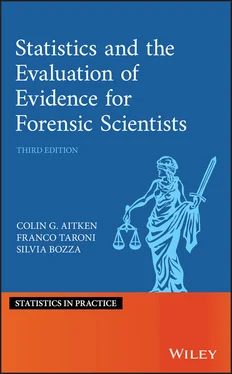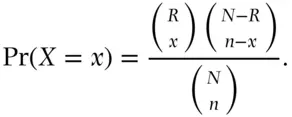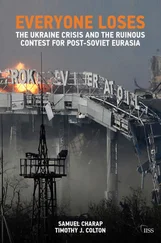Franco Taroni - Statistics and the Evaluation of Evidence for Forensic Scientists
Здесь есть возможность читать онлайн «Franco Taroni - Statistics and the Evaluation of Evidence for Forensic Scientists» — ознакомительный отрывок электронной книги совершенно бесплатно, а после прочтения отрывка купить полную версию. В некоторых случаях можно слушать аудио, скачать через торрент в формате fb2 и присутствует краткое содержание. Жанр: unrecognised, на английском языке. Описание произведения, (предисловие) а так же отзывы посетителей доступны на портале библиотеки ЛибКат.
- Название:Statistics and the Evaluation of Evidence for Forensic Scientists
- Автор:
- Жанр:
- Год:неизвестен
- ISBN:нет данных
- Рейтинг книги:3 / 5. Голосов: 1
-
Избранное:Добавить в избранное
- Отзывы:
-
Ваша оценка:
Statistics and the Evaluation of Evidence for Forensic Scientists: краткое содержание, описание и аннотация
Предлагаем к чтению аннотацию, описание, краткое содержание или предисловие (зависит от того, что написал сам автор книги «Statistics and the Evaluation of Evidence for Forensic Scientists»). Если вы не нашли необходимую информацию о книге — напишите в комментариях, мы постараемся отыскать её.
he leading resource in the statistical evaluation and interpretation of forensic evidence
The third edition of
is fully updated to provide the latest research and developments in the use of statistical techniques to evaluate and interpret evidence. Courts are increasingly aware of the importance of proper evidence assessment when there is an element of uncertainty. Because of the increasing availability of data, the role of statistical and probabilistic reasoning is gaining a higher profile in criminal cases. That’s why lawyers, forensic scientists, graduate students, and researchers will find this book an essential resource, one which explores how forensic evidence can be evaluated and interpreted statistically. It’s written as an accessible source of information for all those with an interest in the evaluation and interpretation of forensic scientific evidence.
Discusses the entire chain of reasoning–from evidence pre-assessment to court presentation; Includes material for the understanding of evidence interpretation for single and multiple trace evidence; Provides real examples and data for improved understanding. Since the first edition of this book was published in 1995, this respected series has remained a leading resource in the statistical evaluation of forensic evidence. It shares knowledge from authors in the fields of statistics and forensic science who are international experts in the area of evidence evaluation and interpretation. This book helps people to deal with uncertainty related to scientific evidence and propositions. It introduces a method of reasoning that shows how to update beliefs coherently and to act rationally. In this edition, readers can find new information on the topics of elicitation, subjective probabilities, decision analysis, and cognitive bias, all discussed in a Bayesian framework.

 . The negative of the Brier score is a strictly proper scoring rule with
. The negative of the Brier score is a strictly proper scoring rule with  and
and  (minimisation of a function corresponds to maximisation of the negative of the function).
(minimisation of a function corresponds to maximisation of the negative of the function). , from a small population. As an example of what
, from a small population. As an example of what  might be, consider tablets in a consignment of drugs; the tablets may be either illicit (
might be, consider tablets in a consignment of drugs; the tablets may be either illicit (  ) or licit. The descriptor ‘small’ for the population size is used to indicate that removal of a member from the population, as in selection without replacement, effects the probability of possession of
) or licit. The descriptor ‘small’ for the population size is used to indicate that removal of a member from the population, as in selection without replacement, effects the probability of possession of  when the next member is selected for removal.
when the next member is selected for removal. . Of the items in the population,
. Of the items in the population,  possess
possess  and
and  do not and
do not and  is not known. A sample of size
is not known. A sample of size  is taken. The probability the first item selected from the population is of type
is taken. The probability the first item selected from the population is of type  is
is  . If the first member selected from the population possesses
. If the first member selected from the population possesses  , the probability the next member selected also possesses
, the probability the next member selected also possesses  is
is  . The population size
. The population size  is sufficiently small that
is sufficiently small that  cannot be approximated meaningfully by
cannot be approximated meaningfully by  . Successive draws from the consignment are not independent in that knowledge of the outcome of one draw affects the probability of a particular outcome at the next draw.
. Successive draws from the consignment are not independent in that knowledge of the outcome of one draw affects the probability of a particular outcome at the next draw. be the number of members of the sample of size
be the number of members of the sample of size  that possess
that possess  . The probability distribution for
. The probability distribution for  is the hypergeometric distribution (Section 4.3.2 and Appendix A.2.5) and
is the hypergeometric distribution (Section 4.3.2 and Appendix A.2.5) and
 members are drawn from the population, only on the number
members are drawn from the population, only on the number  which possess
which possess  and the number
and the number  which do not. The property that the distribution is independent of the order is that of exchangeability.
which do not. The property that the distribution is independent of the order is that of exchangeability. is not known, it is not possible to determine
is not known, it is not possible to determine  . However, it is possible given values for
. However, it is possible given values for  , and
, and  to make inferences about
to make inferences about  . A comparison of the frequentist and Bayesian approaches to this small consignment sampling problem is given in Section 4.3.2 and Aitken (1999).
. A comparison of the frequentist and Bayesian approaches to this small consignment sampling problem is given in Section 4.3.2 and Aitken (1999).










